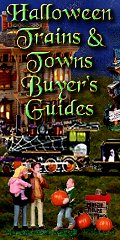 | ||

|
 |  |
 |  | |
 |  | |
 |  | |
 |  | |
 | ||

|
 |  |
 |  | |
 |  | |
 |  | |
 |  | |




|
How Do I Sell My Train Collection?Every so often I get contacted by someone who has accumulated or inherited an extensive train collection of unknown value and who has no interest in keeping the trains. Often there are mixed motivations - a collector's survivors would like to see the formerly cherished trains "go to good homes," but they are also secretly hoping that something in the collection is valuable enough to compensate them from the hassle of becoming its unwilling caretakers. Having recently buried a father who collected trains, I have a pretty good idea how they feel. I almost always find myself wishing I could do more than provide advice from a distance. Sadly, I already have too many trains - I should be selling off, not buying. But I can hopefully give you some useful information and suggestions. First of all, if you are a survivor of a train lover, please accept our heartfelt sympathy. That said, you probably wouldn't be reading this article unless you hoped to - or needed to - achieve some value out of the collection you've inherited (or maybe just accumulated when you had more money and energy). So the balance of this article may seem a little mercenary, but, sadly, financial realities don't change just because these once-cherished treasures came your way under difficult circumstances. Whatever the perceived value of the collection, you should know that:
At the far right are the people who make selling the collection a full time job, but who are really recouping the fruit of their own labor even more than they're recouping the value of the collection. Know What You HaveHopefully, you can see that the collection doesn't even begin to accumulate any value to speak of until you know what you have. If you can't inventory the collection by yourself, consider contacting the appropriate local model railroad club and asking them for help. Maybe you could even offer to make a donation to their treasury if some of their members would come out and put things in order for you. The truth is, unless you have specifics, no one trustworthy will make you an offer worth considering. And nobody with any brains or scruples is going to make a fair bid on your collection unless he or she has some idea of what is included. Don't Trains Always Increase in Value?If you overpay for trains, even desirable pieces take a long time to make that up. Like a new car that loses 25% of its value when you drive it off the lot, folks who pay $500 for a train set that they could have got for $350 with careful shopping are going to wait a very long time before the set is worth $500 again (if it ever is). That doesn't mean it's worthless - kept in good condition, it might be worth $250-300 to the right buyer. But it will be a very long time (perhaps a lifetime) before it's worth what was originally paid for it. In addition, some trains never gain in value, or at least enough to keep pace with inflation. This is especially true with trains that most owners just want to run, including most non-LGB Large Scale (Garden) trains, most HO trains, virtually all toy plastic trains, and even a good percentage of Lionel starter sets (some of which were produced in such numbers, it will take 60 years for them to get rare in any meaningful sense). Another dynamic is that the collector's market for many traditionally collectible trains (like mid-century Lionel and American Flyer) has slowed, and is showing every sign of reversal. After all, the biggest train collectors were people who grew up with real trains as an important part of their lives. Those generations are aging, to say the least, and more and more large collections are coming on the market. That doesn't mean that the truly rare pieces are now worthless, only that, with less demand, they may not command the prices they once did for decades. Worse yet, a lot of mid-range stuff that seemed rare only because it was being hoarded is now getting much easier to find, with sliding "values" to match. What About Price Guides?The first thing you need to know is that most of the values recorded in published guides were set when the economy was good and interest in collecting those trains was at its peak. Even then, they typically represented the maximum an experienced dealer with a shop or a good list of customers might get after he had checked out and cleaned up the piece, then put it on display at significant cost to himself. (Today that dynamic has largely shifted to cleaning it up, photographing it and posting it on eBay by itself, but the principle is the same - the "collectible guide" price includes a lot of personal effort, as well as access to a strong market.")
The other Large Scale (garden railroad) trains tend to drop in value the older they get, because most people buy them to run on their railroads, often outside - a far cry from the hermetically sealed vaults of the professional collectors. To train operators, changing a car's color or number doesn't make it any more useful or collectible, the way it might make a Lionel car more "valuable" to collectors. To add to the confusion many people call any trains that run on 45mm track "LGB," the same way they call Puff facial tissues "Kleenex." But confusing Puffs with Kleenex will not cost you real money. Confusing $50 hardware store train sets with $500 collectibles because they run on the same track could. In fact, I often used to see "LGB collections" advertised on eBay for $500-$1000 without one LGB item (or even any item worth walking to the mailbox for). The "take-away" from this section is that the odds against you having a truly rare collectible in your "collection" are pretty high. But you'll only know for certain if you take the time to inventory each piece and take some steps to see what the individual pieces are worth (see below). You probably don't want to slap a $50 price tag on an unsorted box of trains and always wonder if you gave away something valuable. But slapping a $2000 price tag on an unsorted box of trains in the hope that you have something worth looking at twice usually means you'll be sitting with that box of trains for quite a while. Considering a Donation?If you really don't need the money, or if it's worth any loss of income just to get it out of your way, consider a thoughtful donation to a train club, scouting club, or other charity.
Considering Selling to a Collector or Reseller?If you want to recoup some cash value, the easiest way is to sell the whole thing to a collector or reseller (someone who buys train collections to resell).
Either way, you need to understand that few people who buy collections will can afford to pay much more than 30% of the maximum potential value of your trains if he or she cleaned them up and sold them individually. That is very fair considering the amount of time, energy, and expense they will be putting into it. Taking digital photos and paying eBay fees, or driving to train shows and paying to rent tables - however they plan on getting your trains in front of their customers, they will be investing money and serious time. So what if a piece that the collector paid $50 sells for $150? By the time he's put two hours into cleaning it up, six hours into driving to the train show where he sold it, etc., he may only be making minimum wage or less on that piece. In today's economy very few train collectors or resellers are really in it for the money. Considering Breaking Up the Collection?You will definitely need an inventory, and it will really help you to learn the actual market value of the pieces. As I point out in our FamilyChristmasOnline.com(tm) article, "How Much is My Collectible Worth?", the value of an item equals "whatever an interested party is willing to pay for it today."As mentioned earlier, you maximize your income if you clean up each piece and sell it separately, say on eBay . But you have to decide if, say, an extra 30 hours of work for you is worth another, say, $250. That's not even minimum wage if you think about it. If you DON'T want to liquidate your collection at "wholesale" pricing (or less), your first step is to do a detailed inventory of your collection, including brand, model, model # if you can find one, and condition of each item. Then go to eBay and search for these one item at a time. Put a "watch" on each item that matches one in your collection and see what it actually sells for. This could take some time, maybe 5 hours a week for a month, before you have a general idea of what your collection would be worth if you broke it down and sold it piece by piece. If you CAN'T find a particular item that you think looks like it might be worth something, Google that item and see if you get any hits. If it's an expensive collectible, you'll get hits. If you don't get any hits at all, try finding a few similar items and averaging out the potential valued, or make a short list of things you want to check in a price guide next time you see one somewhere. If you want to break up the collection and try individual sales without going through eBay, a "middle road" might be contacting the appropriate train clubs in your region (Google them) and sending them your inventory, with asking prices set at 60-75% of the final ebay prices you noticed. A Craig's List entry that included your inventory would DEFINITELY get interest, although you might just get "cherry pickers" who would want to take one or two desirable pieces and leave you with common stuff that would be hard to find buyers for. If you discover that your equipment is worth enough money to take seriously, but you don't want to bother with individual sales, you could send your list to a collector, quote a price that is a total of 50% of the total value, and let him negotiate from there. Who Regulates Collectors?Nobody. There is a group called Train Collectors of America that sets standards for judging the condition of collectibles, etc. But they have no way of policing every transaction made by every individual member. Occasionally a collector will give you his TCA number as "proof" that he is an ethical person. Most TCA members I've known were, but I have learned not to take the TCA membership as proof that an individual member always deals fairly with those outside of the "club." What About Leftovers?If, after all your research, you decide that what you have is not really worth that much money, or if you've got a bunch of stuff left over after selling off the best stuff, you might think again about the deduction option. If you're not concerned with the tax deduction, there's probably a local train club that would be grateful to have more inventory for their public displays. ConclusionParts of this article may sound a little harsh, and hopefully your experience will be more positive than most, but I wanted you to be aware of the market dynamics before some circumstance or less-than-transparent person blindsided you.
In the meantime, take time to appreciate the pleasure these trains once gave, and remember their collector thougthfully (even if it's you at an earlier age). And the next time you're in the attic, you might think about whatever "collection" your own heirs may wind up sorting through. Did you REALLY need all of those Beany Babies? Or eleven guitars? Or . . . ? Best of luck, all. Please let me know if you have any feedback, and have a great summer, See you online, Paul |
 


|
 Return to the Blog-Like Content Menu
Return to the Blog-Like Content Menu
To read more, or to look at recommended Garden Railroading and Display Railroad products, you may use the search button below or click on the index underneath it.
 |  |

| 
|
 |
 |
 |  |  |
Note: Family Garden TrainsTM, Garden Train StoreTM, Big Christmas TrainsTM, BIG Indoor TrainsTM, and BIG Train StoreTM are trademarks of Breakthrough Communications (www.btcomm.com).
All information, data, text, and illustrations on this web site are Copyright (c) 1999, 2000, 2001, 2002, 2003, 2004, 2005, 2006, 2007, 2008, 2009, 2010, 2011, 2012 by Paul D. Race.
Reuse or republication without prior written permission is specifically
forbidden.
Family Garden Trains is a participant in the Amazon Services LLC Associates Program, an affiliate advertising program designed to provide a means for sites to earn advertising fees by advertising and linking to amazon.com.
For more information, please contact us